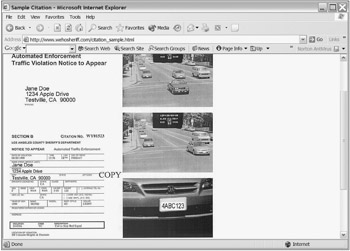Workplace Surveillance
Big Brother is watching! At a casino in Atlantic City, an infrared sensor keeps a computer log that tracks each time an employee fails to wash his or her hands after using the bathroom. At a college in Massachusetts, a secretary was informed that a camera installed to deter nighttime intruders had instead captured her changing clothes in the privacy of her own office during the day. An employee at a company that produces porn was fired because he spent too much time on eBay and not enough time watching porn. These are but a few examples of workplace surveillance cited by Frederick Lane in his new book, The Naked Employee: How Technology is Compromising Workplace Privacy (AMACOM, 2003). As Lane describes in Chapter 6, 14 million employees ”more than one-third of the American workforce ”have their Internet or e-mail under continuous workplace surveillance. In most cases it's legal, but the least you can do is ascertain whether you're being watched. Be discrete and sniff around.
How might your employer be spying on you? There are several ways.
-
Telephone. The ACLU estimates that employers eavesdrop on about 400 million telephone calls annually. Federal wiretap laws forbid eavesdropping on conversations unless one of the parties in the conversation consents, but the Electronic Communications Privacy Act of 1986 allows employers to listen to job- related conversations. A recent American Management Association (AMA) study estimates that 12 percent of employees' phone calls and 8 percent of their voicemail is reviewed in the workplace.
-
Closed-circuit television. The same AMA study estimates that 15 percent of the American workforce is monitored by closed-circuit TV (CCTV).
-
Packet sniffers. A packet sniffer is a program that can monitor information you send over your company's network. With a packet sniffer, your system administrator can ascertain who you send e-mail to, the content of the text, the Web sites you visit, and what you download.
-
Desktop-monitoring programs. Every keystroke you type sends a signal from the keyboard to an application. Desktop-monitoring programs, such as iSpyNOW, monitor every keystroke by intercepting the signal and recording it stroke-for-stroke. System administrators usually install the monitoring software, but keystroke interceptors are also a popular way for hackers to steal passwords.
-
Log files. Your computer is full of log files that provide evidence of what you've done. With these log files, a system administrator can determine what Web sites you've accessed, to and from whom you're sending and receiving e-mail, and what applications you've been using.
Workplace Privacy
Forget about it! American courts tend to favor the employer in workplace-surveillance cases. The US Constitution contains no express right to privacy, but the US Supreme Court has historically upheld an implied right to privacy. This right doesn't apply to employees, however. The courts seem to uphold the idea that because the company owns the equipment and office space, it has a right to monitor its employees to prevent misuse of that equipment and space. For this reason, you should always be prudent when logging onto the Internet and sending e-mail. Choose your words carefully . You never know who might be reading them!
Photo Enforcement
The consensus of opinion is photo enforcement is an effective deterrent to traffic accidents triggered by drivers who run red lights. I make a conscious effort to detour around photo enforcement, however. People drive unpredictably around photo-enforced traffic lights; they either speed up or slow down. In my empirical observation photo enforcement alters logical behavior and impedes the normal flow of traffic. That's why I avoid photo enforcement like the plague!

Figure 14.4: West Hollywood Sheriff's Station photo enforcement site photos
I actually have nightmares about receiving a $271 ticket from my city in the mail. And I don't run red lights! Photo-enforcement citations amount to nothing less than a stealth tax. The top three causes of traffic accidents are inattention, failure to yield, and DUI. Photo-enforcement cameras do nothing to prevent these kinds of accidents. Experts believe that improved roadway engineering, lengthening of the yellow-light phase, and better signage are the best ways to prevent traffic accidents. In my opinion photo enforcement is just another example of how Kafkaesque society has become.
That's All, Folks!
By now you know I have very strong opinions when it comes to the subject of privacy. My objective in writing this book was not to sway your opinion but to provide you with enough facts and information to draw your own. I could go on but feel I've met my objective. I hope this book helps you in you everyday life and that you enjoyed reading it. Good luck!
EAN: 2147483647
Pages: 135